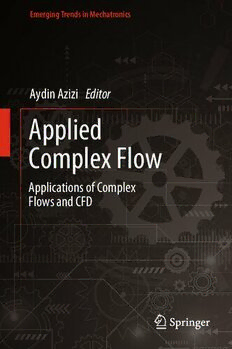Table Of ContentEmerging Trends in Mechatronics
Aydin Azizi Editor
Applied
Complex Flow
Applications of Complex
Flows and CFD
Emerging Trends in Mechatronics
SeriesEditor
AydinAzizi,Oxford,UK
Aydin Azizi
Editor
Applied Complex Flow
Applications of Complex Flows and CFD
Editor
AydinAzizi
SchoolofEngineering,Computing
andMathematics
OxfordBrookesUniversity
Oxford,UK
ISSN 2731-4855 ISSN 2731-4863 (electronic)
EmergingTrendsinMechatronics
ISBN 978-981-19-7745-9 ISBN 978-981-19-7746-6 (eBook)
https://doi.org/10.1007/978-981-19-7746-6
©TheEditor(s)(ifapplicable)andTheAuthor(s),underexclusivelicensetoSpringerNature
SingaporePteLtd.2023
Thisworkissubjecttocopyright.AllrightsaresolelyandexclusivelylicensedbythePublisher,whether
thewholeorpartofthematerialisconcerned,specificallytherightsoftranslation,reprinting,reuse
ofillustrations,recitation,broadcasting,reproductiononmicrofilmsorinanyotherphysicalway,and
transmissionorinformationstorageandretrieval,electronicadaptation,computersoftware,orbysimilar
ordissimilarmethodologynowknownorhereafterdeveloped.
Theuseofgeneraldescriptivenames,registerednames,trademarks,servicemarks,etc.inthispublication
doesnotimply,evenintheabsenceofaspecificstatement,thatsuchnamesareexemptfromtherelevant
protectivelawsandregulationsandthereforefreeforgeneraluse.
Thepublisher,theauthors,andtheeditorsaresafetoassumethattheadviceandinformationinthisbook
arebelievedtobetrueandaccurateatthedateofpublication.Neitherthepublishernortheauthorsor
theeditorsgiveawarranty,expressedorimplied,withrespecttothematerialcontainedhereinorforany
errorsoromissionsthatmayhavebeenmade.Thepublisherremainsneutralwithregardtojurisdictional
claimsinpublishedmapsandinstitutionalaffiliations.
ThisSpringerimprintispublishedbytheregisteredcompanySpringerNatureSingaporePteLtd.
The registered company address is: 152 Beach Road, #21-01/04 Gateway East, Singapore 189721,
Singapore
Preface
Most fluids exhibit a complex behaviour that is directly linked to their stress-
deformationrelationship.Whethertheaforementionedrelationissimplynonlinear
orlinearbutcombinedwithanexternalforce(thermal,chemical,magneticoretc.),
theliquidsthatarebeingdealtwitharecollectivelyclassedas“ComplexFluids”.
This book is aimed to present improved numerical techniques and applied
computer-aidedsimulationsasapartofemergingtrendsinmechatronicsinallareas
relatedtocomplexfluids,withaparticularfocusonusingacombinationofmodelling,
theory,andsimulationtostudysystemsthatarecomplexduetotherheologyoffluids
(i.e.,ceramicpastes,polymersolutionsandmelts,colloidalsuspensions,emulsions,
foams, mico-/nanofluids, etc.) and multiphysics phenomena in which the interac-
tionsofvariouseffects(thermal,chemical,electric,magnetic,ormechanical)lead
tocomplexdynamics.Theareaofapplicationsspansaroundmaterissalsprocessing,
manufacturing, and biology. In the following, a brief overview of each chapter is
presented.
Oxford,UK AydinAzizi
v
Contents
ModelingHemodynamicsofRotaryBloodPumpsandPredicting
thePotentialRisks ................................................. 1
LeonardoN.Rossato,JonathanKusner,andFarhadR.Nezami
Microfluidic-IntegratedBiosensors .................................. 21
FatemehShahbazi, MasoudJabbari, MohammadNasrEsfahani,
andAmirKeshmiri
DropletMicrofluidics:AMultiphaseSystem ......................... 43
MaryamFatehifar,AlistairRevell,andMasoudJabbari
SubjectSpecificModellingofAorticFlows ........................... 69
AminDeyranlou,AlistairRevell,andAmirKeshmiri
3DPrintingofPolymerComposites ................................. 107
HamidNareiandMasoudJabbari
MagnetorheologicalFluids ......................................... 125
HesamKhajehsaeid,EhsanAkbari,andMasoudJabbari
CeramicManufacturingforGreenEnergyApplications ............... 149
MasoudJabbari, HesamKhajehsaeid, MohammadSouri,
andMohammadNasrEsfahani
RheologyandCureKineticsofModifiedandNon-modifiedResin
Systems ........................................................... 169
HatimAlotaibi,ConstantinosSoutis,andMasoudJabbari
vii
Modeling Hemodynamics of Rotary
Blood Pumps and Predicting
the Potential Risks
LeonardoN.Rossato,JonathanKusner,andFarhadR.Nezami
Abstract Theglobalburdenofcardiovasculardiseaseisimmense.Withinthisbroad
categoryofdiseases,heartfailureisrecognizedasamajorcontributortobothadverse
patienteventsandhealthcarespending.Aswesternpopulationsage,epidemiologic
dataprojectssignificantincreasesintheprevalenceofheartfailure.Thegapbetween
thosewithend-stageheartfailureandtheavailabilityofhearttransplantscontinuesto
widen,compellingthetransitionofmechanicalsupportsolutions,initiallydeveloped
asabridgetotransplanttherapies,todestinationtherapiesforthousandsofpatients
eachyear.Unfortunately,patientsreceivingthesedevicescontinuetobeplaguedbya
rangeofadverseeventsrelatedtoincompletelyoptimizedblood–deviceinteractions
impactinghemolysisandthrombosis.Bloodpumps,theprincipalcomponentofsuch
assistdevices,arethefocusofongoingstudyasattemptsaremadetooptimizetheir
performance and minimize any associated risks. Fortunately, with recent advance-
mentsincomputationalpowerandsimulationmethods,suchascomputationalfluid
dynamics(CFD),reliableapproacheshaveemergedtoassessthehemodynamicsof
blood pumps and explore their hydraulic, hemolytic, and thrombolytic challenges.
Thesemethodsobserveseveralcomplexpropertiesandinteractionsthatoccurwithin
blood pumps, including the rheological properties of blood as well as the multi-
componentmotionofthepumpimpeller.Thischapterinitiallyfocusesonpreparing
CFD frameworks for modeling rotary blood pumps, from geometry creation and
meshingthroughmoreadvancedmethodsofbloodmodeling,includingturbulence
modelimplementation.Thisisfollowedbyapresentationofseveralapproachesused
tovalidatenumericalmodelsincludinginvitroexperimentsandtheuseofestablished
parametric benchmarks. Finally, we discuss how to compose available methods to
quantitatetheriskofhemolysisandthrombosiswithinrotarybloodpumps.
B
L.N.Rossato·F.R.Nezami( )
ThoracicandCardiacSurgeryDivision,DepartmentofSurgery,BrighamandWomen’sHospital,
HarvardMedicalSchool,Boston,MA,USA
e-mail:[email protected]
L.N.Rossato
e-mail:[email protected]
J.Kusner
DepartmentofMedicine,DukeUniversitySchoolofMedicine,Durham,NC,USA
e-mail:[email protected]
©TheAuthor(s),underexclusivelicensetoSpringerNatureSingaporePteLtd.2023 1
A.Azizi(ed.),AppliedComplexFlow,EmergingTrendsinMechatronics,
https://doi.org/10.1007/978-981-19-7746-6_1
2 L.N.Rossatoetal.
1 Introduction
Cardiovascular diseases remain one of modern medicine’s most significant chal-
lenges,routinelytoppingthelistofglobalcausesofdeathinadults[1].Aspopula-
tions age, the prevalence of heart disease increases. Specifically, the prevalence of
heartfailure(HF),oncethoughttobeonthedecline[2],hasbeenre-evaluatedwith
newdatanotonlyshowingittobeincreasing,butalsoassociatedwithadevastating
diseaseburdenthatisstraininghealthcaresystemsglobally[3].IntheUnitedStates
(US) alone, more than 6.2 million patients have a diagnosis of HF [4], driving an
associatedannualmortalityrateof380,000deaths[4]and$30billioninhealthcare
spending each year [5]. This disease burden is expected to grow steeply such that
by 2030 the cost of HF-related healthcare in the US is projected to be $70 billion
annually[5].Despitethisspending,survivalratesofHFpatientsremainalarmingly
low,withestimates,forthosemanagedinthecommunity,of80%atoneyearfrom
diagnosis,whichfallsto50%atfiveyears[6,7].Evenwithadvancesinmedications
andhealthcaredelivery,hearttransplantation(HT)remainsanimportanttherapeutic
optionforpatientswithend-stageHF.
The prevalence of end-stage HF has consistently exceeded the capacity of HT.
Unfortunately, as the prevalence of HF, including end-stage HF, has increased,
the annual volume of HT remains stagnant at around 3000 transplants annually
in the US [8, 9]. Due to this epidemiologic mismatch, ventricular assist devices
(VAD), although initially developed as bridge-to-transplant (BTT) therapies for
patients awaiting HT, are necessarily becoming destination therapies (DT). For
patientsreceivingVADtoday,nearly50%areindicatedasDT,26%constituteBTT,
while the remaining 24% are used in bridge-to-decision, bridge-to-candidacy, and
bridge-to-recoveryscenarios[10].
Many solutions to advanced and end-stage HF are being pursued, including
gene therapies, improving logistics and technics for HT, xenotransplantation, and
mechanical circulatory support. For the foreseeable future, VAD will remain an
important therapeutic option for patients with end-stage HF. The medical commu-
nity’s experience with VADs continues to expand, with greater than 2500 devices
newlyimplantedeachyear[10].VADsareassociatedwithsystemicimprovementsas
totalbodycirculationisre-established[11].Thisisreflectedinannualizedsurvival,
withVADpatientsintheUSexperiencingone-yearsurvivalof81and70%attwo
years [10]. Despite these encouraging survival figures, these patients experience
highratesofVAD-relatedadverseevents(AEs),includingcomplicationsrelatedto
infection,bleeding,andclotting[12].Improvedunderstandingoftissue-devicerela-
tionships and blood circulation through VAD devices are critical in reducing AEs
andimprovingsurvivalinpatientswithVAD.
ThemostcriticalandcomplexcomponentofVADisthebloodpump,whichis
principallycharacterizedbytheactuationmethodintotwomaincategories:displace-
mentpumpsandrotarybloodpumps.Thischapterwilladdressrotarybloodpumps
aloneastheyareassociatedwithbetterclinicaloutcomesandaremorecommonly
implanted. In addition, rotary pumps have higher power efficiency, allowing for
ModelingHemodynamicsofRotaryBloodPumpsandPredicting… 3
smallerdeviceprofilesandsimplersurgicalimplantation.Easeofimplantationand
superiordeviceperformancehavedriventhereal-worldutilizationofrotarypumps
overdisplacementpumps.
Rotary pumps transfer the kinetic energy into the bloodstream as they achieve
physiologiccardiacoutputs.Excellenthydraulicperformanceisneededtobalance
this introduction of energy while minimizing damage to the blood and supplied
organs. The study of blood–device compatibility in VAD interrogates this balance
withafocusonreducinghemolysis(thedestructionofredbloodcells)andthrom-
bosis(bloodclotting).BothhemolysisandthrombosisinVADareassociatedwith
significantcomplicationsthatdrivemorbidityandmortalityinpatientswhorelyon
thesedevices.
Although relevant to all patients, blood–device compatibility is critical to the
increasing segment of patients receiving DT VAD. In addition to biological and
biochemical aspects of such compatibility, the mechanical design and hemody-
namicperformanceofpumpssignificantlyimpactdevicedurabilityandtheratesof
AE.Numericalmodels,suchascomputationalfluiddynamics(CFD),havebecome
fundamental tools for designing and optimizing mechanical circulatory support
pumps. Computational methods represent a cost-effective and ethical set of tools
thatprovideuniqueinsightsintothecomplexfluiddynamicsofVADs.Thesetools
enabletime-resolvedquantificationofimportantfluiddynamicparametersrelatedto
blooddamageandhydraulicperformance.CFDanalysisisinstrumentalincharacter-
izingcomplexturbulencefeatures,suchasrecirculationandstagnationzonesthatare
flowpatternsimplicatedinhemolysisandthrombosis[13,14].Significantincreases
incomputationalpowerpairedwithimprovedmodelsofhumanphysiologyforward
the use of CFD for the study, development, and optimization of mechanical circu-
latorysupportpumpsandunderstandingtheirrelationshipwithhumanphysiology
post-implantation.
This chapter will overview how CFD models are leveraged to characterize the
characterization of the hemolytic, thrombotic, and hydraulic potential of rotary
blood pumps. The first section will discuss the process and components of devel-
opingaCFDsimulation,includingmeshgenerationandgoverningequationsrelated
to pump hemodynamics. Following that, we will explain the process and signifi-
cance of modeling the rheological properties of blood, how to numerically induce
pumpimpellermotion,andhowtoproperlyaccountfortheeffectsofturbulencein
bloodpumps.Finally,wewillintroducecomputationalapproachestoquantifyblood
damageintheformsofhemolysisandthrombosis.
4 L.N.Rossatoetal.
2 HemodynamicsModelingUsingCFD
2.1 TypesofRotaryBloodPumps
Rotary pumps are classified according to the positioning of the outlet(s) and flow
orientation. In centrifugal pumps, the outlet is positioned tangentially at the end
of the pump housing, whereby the impeller rotation linearly accelerates the blood
flow. As a result, such pumps are generally characterized by a high ratio between
pressureheadandrotationspeed,reducingthehemolyticpotentialofthepumpdue
tolowerblooddamagelevelsthanotherpumps.Furthermore,duetothegeometryof
therotor,centrifugalpumpscanmakeuseofmagneticorhydrodynamiclevitating
bearing suspension systems to minimize the potential risk for pump thrombosis.
Finally,thereductioninstagnationzones,commonlyfoundnearimpellerbearings,
increasestheoveralldurabilityofthisvarietyofpumps(Fig.1).
Inaxialpumps,boththeimpellerandtheoutletarecollinear,resultinginlinear
androtationalpropulsionoftheflow.Thesepumpstendtooperateathighspeedsto
supplythereducedpressurehead;consequently,theyaremorelikelytoinduceblood
damage.Furthermore,axialpumpsrequirestationaryguidevanes,whichhavedirect
contactbetweenbearingsandimpeller,aggravatingtheirhemolyticandthrombotic
potential and accelerating pump wear. Thus, axial pumps tend to have a shorter
servicelifeascomparedtocentrifugalpumps,withanaveragedurabilityoflessthan
fiveyears.Anadvantageofaxialpumpsistheirsmallersizewhichconfersgreater
energyefficiency,renderingthemmoresuitableforpediatricapplications.
Fig.1 Essentialcomponentsof(a)acentrifugalbloodpumpand(b)anaxialflowbloodpump.
Picturesareadaptedfrom[15]withpermissionfromTrendsinBiomaterialsandArtificialOrgans

